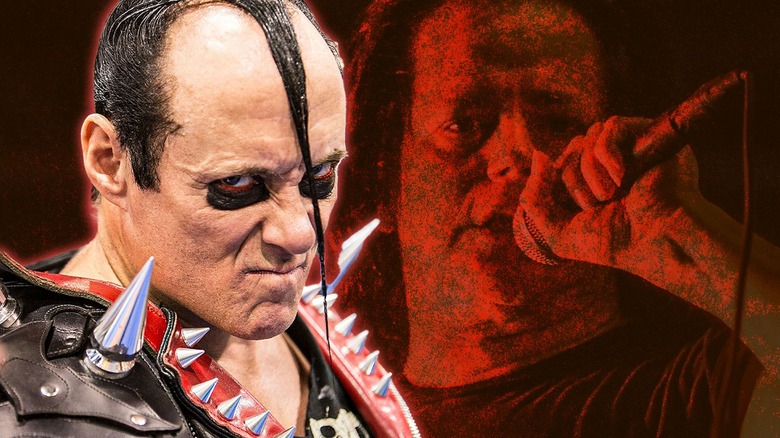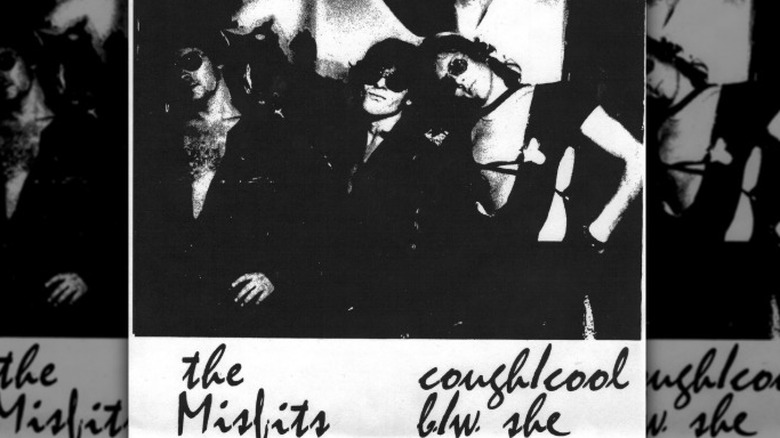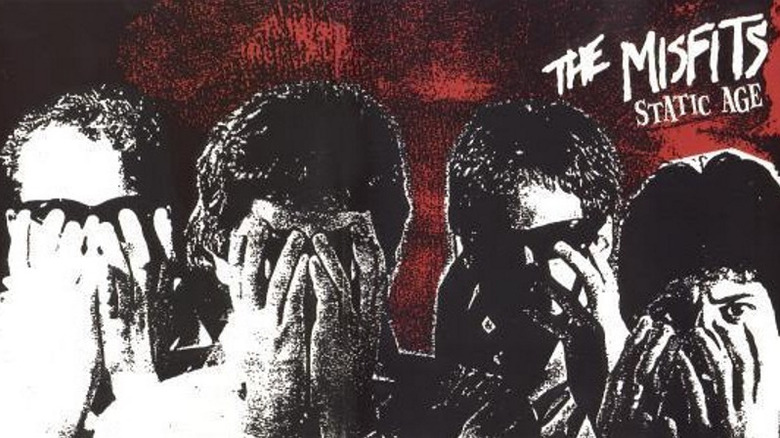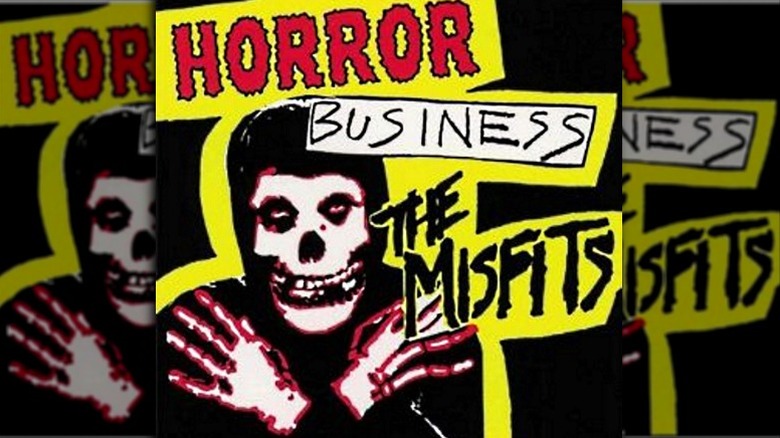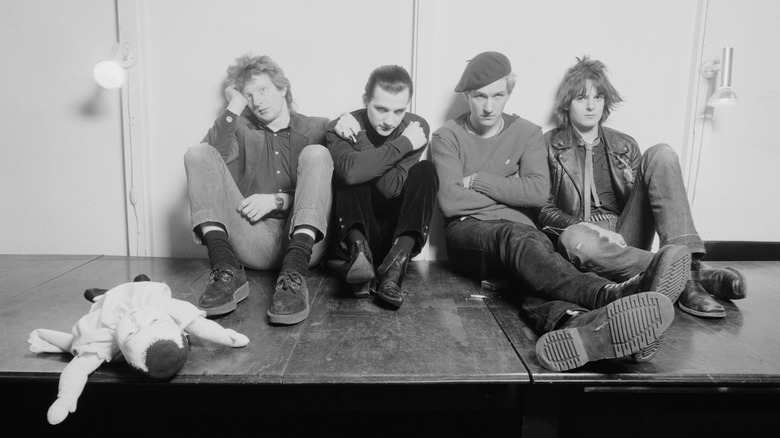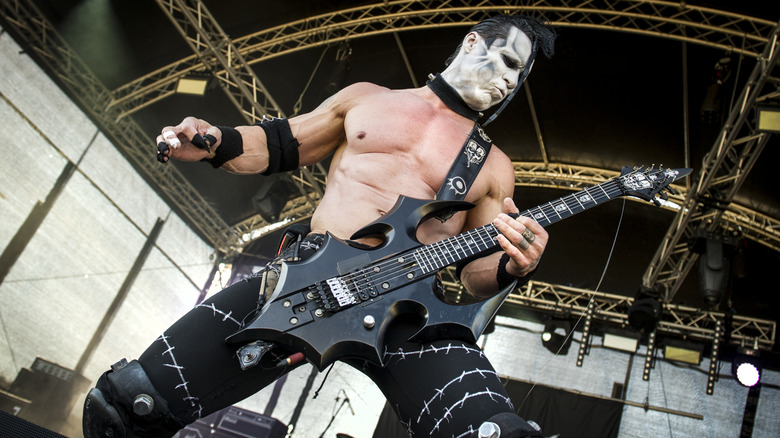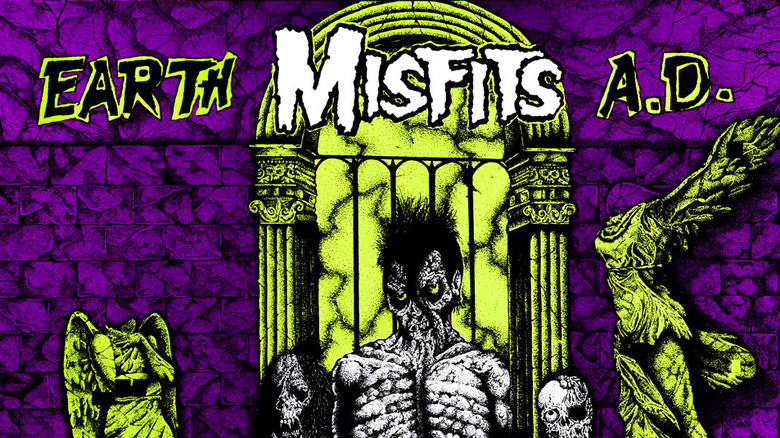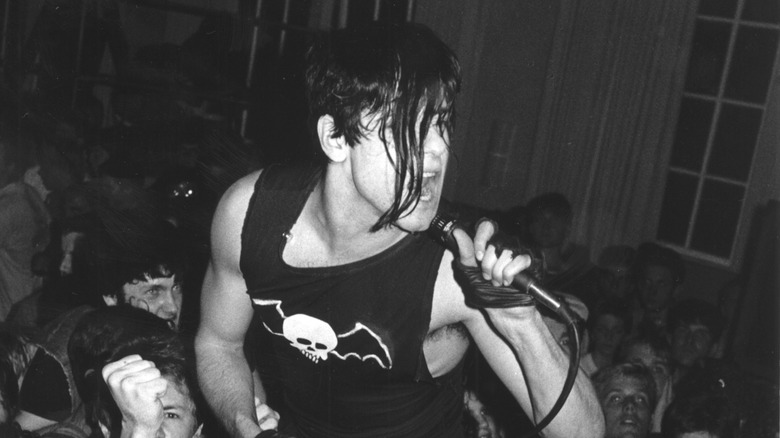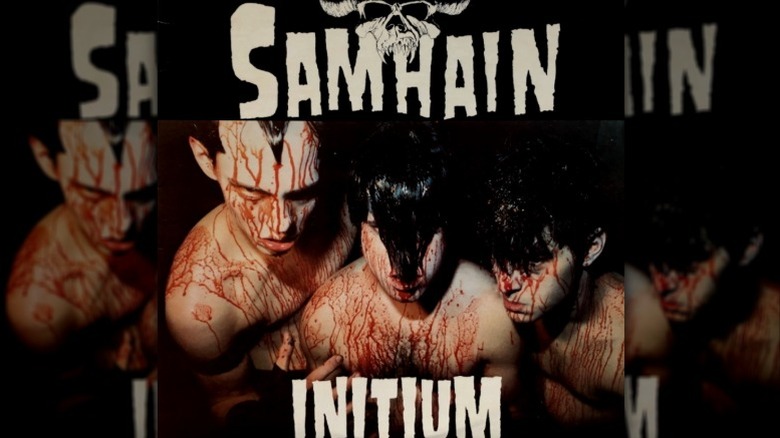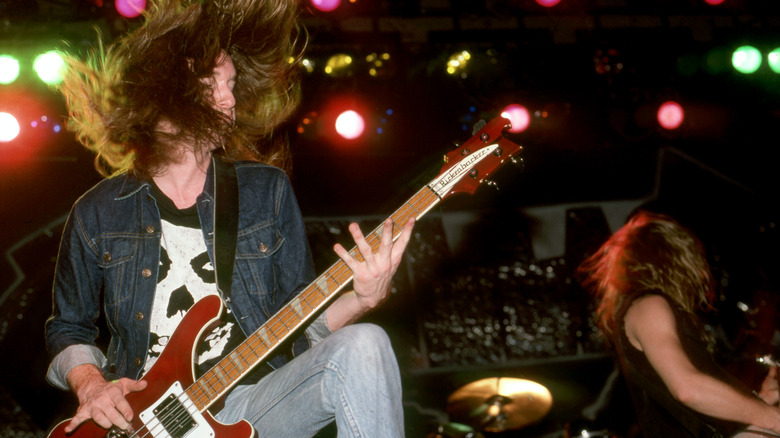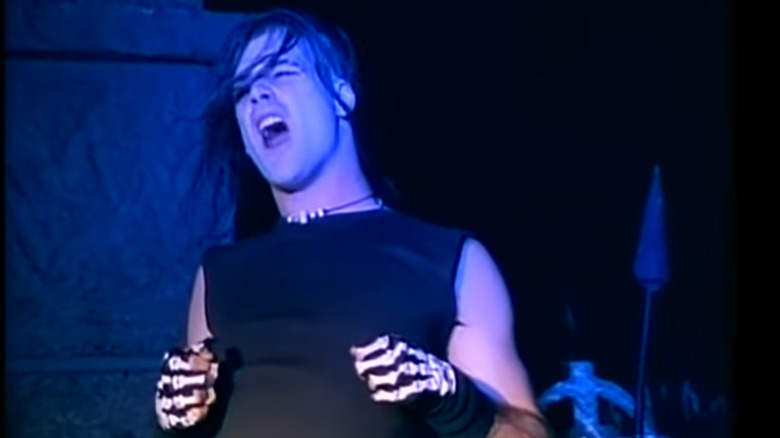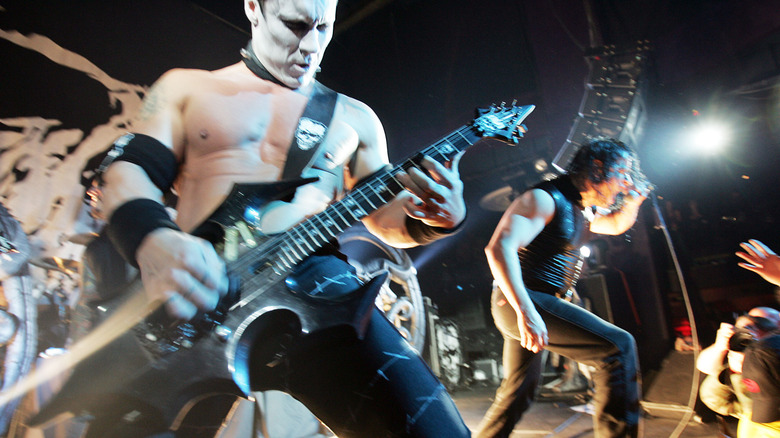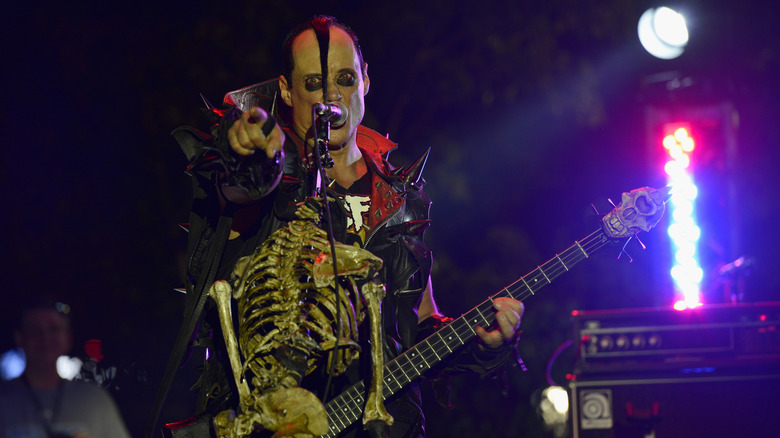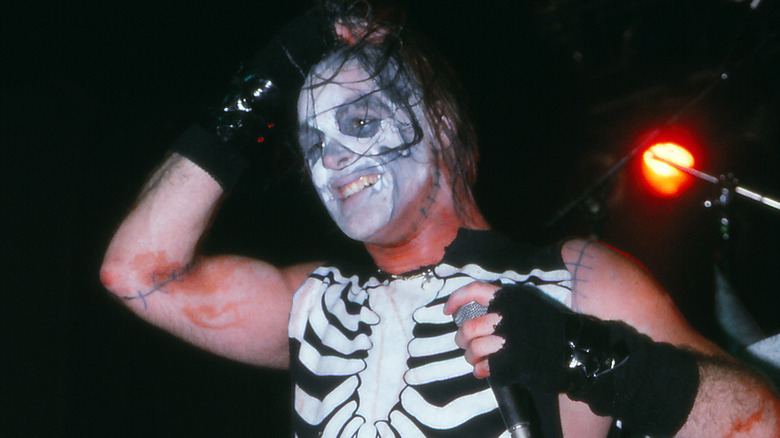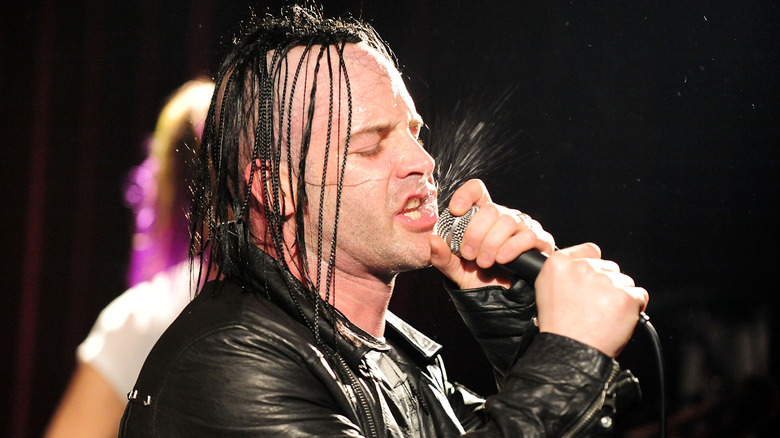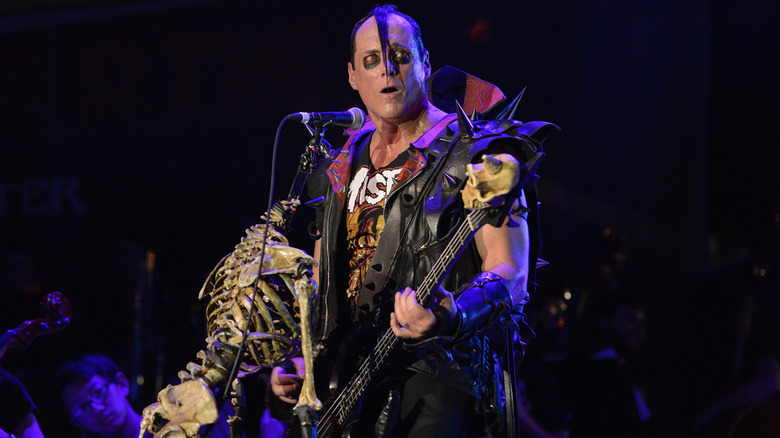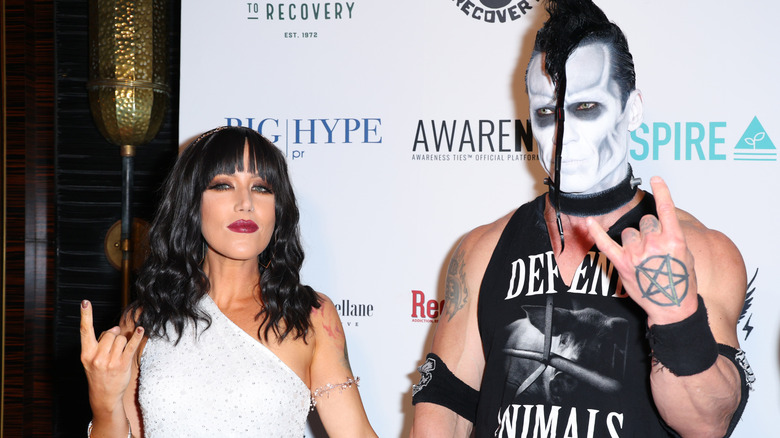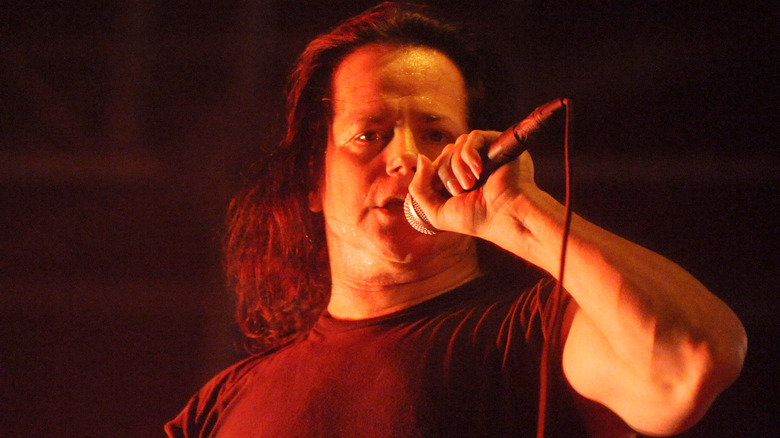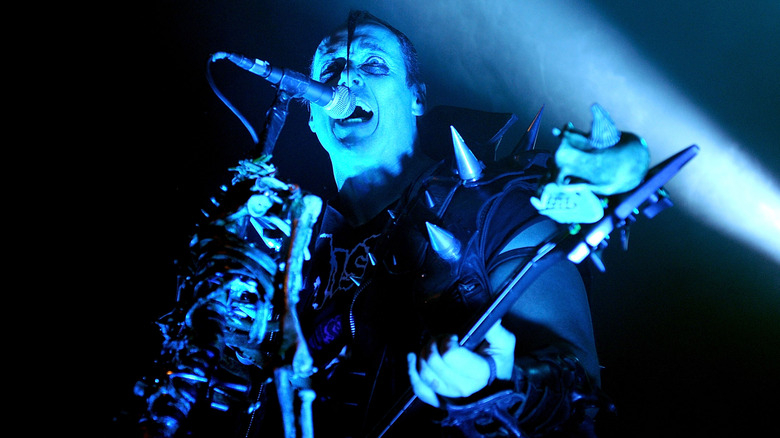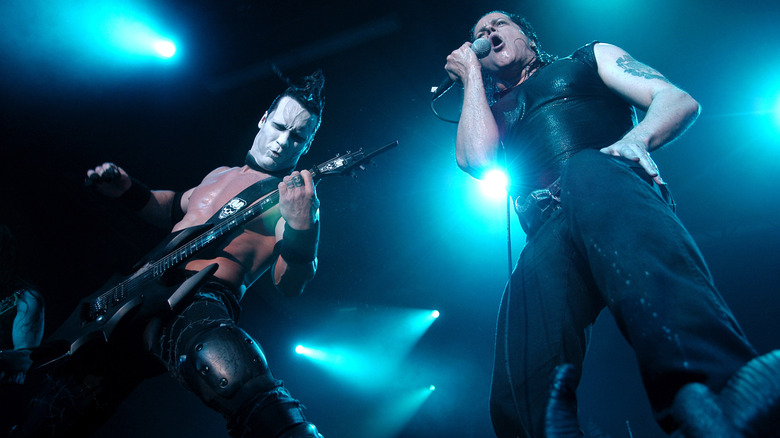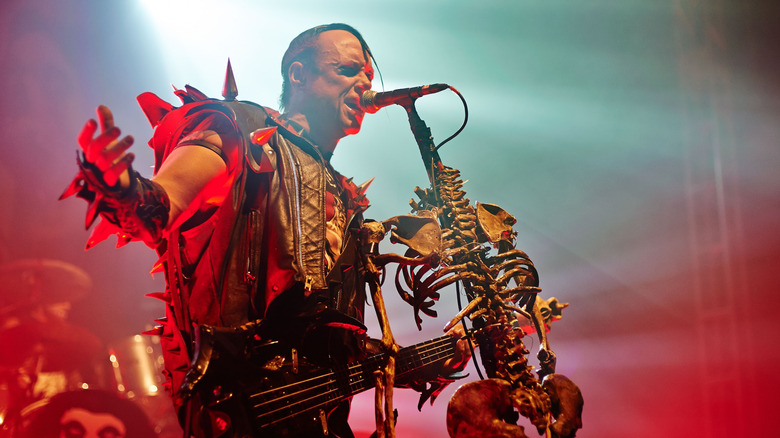The Untold Truth Of The Misfits
Although the band never received the accolades of The Clash, the reputation of The Ramones, or the notoriety of The Sex Pistols, The Misfits nonetheless made an indelible mark on punk rock. Founded by Glenn Danzig in 1976, The Misfits ignored the political posturing and art-school pretense of its contemporaries to focus on themes of horror and violence. With the "Crimson Ghost" — the skull-faced villain of a 1946 film serial — as its mascot, the band was rooted in stripped-down, 1950s style rock 'n' roll infused with aggression and attitude. By 1983, the band, having moved to a faster, hardcore style, collapsed under the weight of lineup changes and infighting.
Despite growing post-breakup popularity, The Misfits was mired in lawsuits and bad blood for decades. In 1995, bassist Jerry Only and his brother, final classic-era Misfits guitarist Doyle Only, recruited unknown vocalist Michale Graves for an all-new incarnation of the band. The reformed Misfits, with its cartoonish focus on monster movie imagery, split their fanbase. Meanwhile, Danzig was content to put The Misfits behind him, seemingly forever.
For decades, Misfits fans held out hope for an eventual reunion of Danzig and Only. In what can only be described as a punk rock miracle, the feuding musicians at last settled their long-standing legal differences in 2016 for a series of sold-out reunion concerts. From their early days as pop-culture-obsessed DIY punks to their incredible third act as unlikely arena rockers, this is the untold truth of The Misfits.
The Misfits' humble beginnings
Born Glenn Anzalone on June 23, 1955, in Lodi, New Jersey, Glenn Danzig, like many disaffected suburban kids in the '60s, grew up hooked on comics and horror movies. A self-described outsider, Danzig had little patience for his peers or their tastes. "Growing up, while everyone else was reading stupid s***, I was reading Edgar Allan Poe and Baudelaire," Danzig told The Stranger in 2013. "I loved horror movies, and I really liked underground comics."
After graduating from Lodi High School in 1973, Danzig developed an interest in music, spurred by his "hatred of everything." With a taste for heavy music like Black Sabbath, the singer joined his first band, Talus, in 1975. By 1976, he was ready to realize a new musical vision, one that would incorporate his offbeat interests and obsessions. New York's rising punk rock movement seemed the perfect vehicle.
Naming his new band The Misfits after Marilyn Monroe's final film, Danzig recruited bassist Diane DiPiazza and drummer Manny Martinez. Failing to show up for rehearsals, Piazza was soon replaced by Jerry Caiafa. With Caiafa, a 17-year-old high school jock turned punk, on bass (an instrument he had only been playing for a month), a guitarless Misfits featuring Danzig on vocals and electric piano, released their first single, "Cough/Cool," backed with "She," a paean to heiress turned SLA bank robber Patty Hearst, in August of 1977.
A lucky break got The Misfits free studio time
Released on Glenn Danzig's label, Blank Records, "Cough/Cool" was limited to a modest pressing of 500 copies. Still, the short run was enough to attract the attention of a major label, but not in the way that Danzig and The Misfits might have hoped. Mercury Records wanted Blank as an indie imprint and was willing to make a deal to get it. In exchange for 30 hours of studio time, The Misfits gave up Blank Records and rechristened its label Plan 9 in a nod to Ed Wood's infamous movie.
In early 1978, The Misfits — consisting of Danzig, Jerry Caiafa (now known as Jerry Only upon his insistence on being credited as "Jerry. Only Jerry" after his surname was misspelled on "Cough/Cool" ), drummer Jim "Mr. Jim" Catania, and guitarist Frank "Franché Coma" Licata — entered the studio to record what they intended to be their debut album, "Static Age." Over the course of 20 hours, the band recorded 17 songs, including early versions of "Teenagers From Mars," "Hybrid Moments," and "Last Caress." However, the band was unable to generate studio interest in the album.
Danzig would wind up releasing many of the recordings as singles and EPs. "Static Age" was at last released in 1996 as part of a Misfits boxset, followed by a 1997 standalone release featuring newly mixed versions of "She," "Spinal Remains," and the rarity "In The Doorway."
The Misfits embrace their horror image
Fueled by Glenn Danzig's creativity and funded by Jerry Only's day job at his father's machine shop, The Misfits developed a loyal following playing shows in New Jersey and New York. Entrenched in a diehard do-it-yourself ethic, Danzig designed the artwork for The Misfits' self-released records, folding and gluing the sleeves by hand.
With the 1978 departure of Franché Coma and Mr. Jim, The Misfits again found itself in need of a guitarist and drummer. The next lineup featured Bobby Steele, a veteran of the New York punk scene, and drummer Joey Image. It was during this era that the band began incorporating horror elements into its image. A typical Misfits gig began with horror movie trailers projected onto a huge roll of seamless paper draped in front of the stage. As the last clip ended, the band would strike its first ear-splitting chord and smash through the screen. The look of the band also became more cohesive. Danzig, clad in a homemade skeleton shirt, and Only in leather and spikes, were both now sporting exaggerated, chin-length, Dracula-style widows' peaks that would come to be known as devillocks.
The flyer for the band's final show at New York's Max's Kansas City featured The Misfits' first use of the iconic Crimson Ghost. Lifted from the 1946 Republic film serial of the same name, the Crimson Ghost would become The Misfits' mascot and the image most associated with the band.
A disastrous tour of England nearly ends The Misfits
The Misfits opened for British punk band The Damned (pictured above) at a New York club called Hurrah in June of 1979. Prior to taking the stage, Misfits bassist Jerry Only discussed the possibility of opening for The Damned on a United Kingdom tour with the band's vocalist Dave Vanian. From this point, the details of The Misfits' ill-fated tour of Britain become somewhat murky.
Glenn Danzig and Only booked the tour through England's musician's union and received a contract outlining tour dates and pay from The Damned's manager. On November 21, 1979, The Misfits arrived in England and Only went to Vanian's home to work out some final details. The visit came as a complete surprise to Vanian, who hadn't taken Only's offer seriously. Compounding the confusion, Only had neglected to sign the contracts drawn up by The Damned's management. The Misfits was hurriedly added to The Damned's tour, but frustration over lack of pay, likely stemming from the unsigned contracts, and frustration with rented gear led the band to quit after one show.
Stranded in England and surviving on Only's father's credit cards, The Misfits nearly fractured. Drummer Joey Image booked a flight back to the United States, effectively quitting the band. While Only went sightseeing with the mother of Sid Vicious, whose tragic life had recently ended, Bobby Steele and Danzig landed in jail after a violent confrontation, allegedly with local skinheads. Their two-night stay in London's Brixton jail was immortalized by Danzig in The Misfits' song, "London Dungeon."
Exit Bobby Steele, enter Doyle
In 1980, The Misfits replaced guitarist Bobby Steele with Jerry Only's towering 16-year-old brother, Paul Caiafa. Rechristened "Doyle," the younger Caiafa's entry into the band was marked with controversy. According to Only, Bobby Steele was unreliable and often missed practice. "The problem was that Bobby's problems were bigger than the band problems," Only told "American Hardcore" author Steven Blush. "If Bobby had something to do, then the band came second ... we eventually replaced Bobby with Doyle — and the rest is history. Doyle is a phenomenon as far as guitar players go."
Glenn Danzig remembers Steele's exit differently. "Jerry didn't want Bobby anymore," Danzig said. "They wanted Bobby out and Doyle in. I said, 'Look, I don't really care, but don't lead Bobby on anymore.' I was teaching Doyle stuff on guitar, and it wasn't working — his hands were just too big ... They didn't tell Bobby, so I did. They wanted him to come down to the show and not know he was out ... which was not cool."
Steele never received a satisfactory explanation for his firing. "I've heard so many different reasons," Steele told Blush. "At the time, Glenn didn't want to tell me why ... [Jerry] told me it was because I sucked on guitar, that Doyle was better. I told him on the spot, 'You know I'm a far better guitarist.' 'Well, Doyle looks better.' ...I've always suspected that Jerry wanted his brother in the band so Jerry could have more influence."
The Misfits go hardcore with Earth A.D./Wolfs Blood
The Misfits finally recorded a full-length debut album in 1981. Released in 1982, "Walk Among Us" featured the lineup of Glenn Danzig, Doyle, Jerry Only, and new drummer Arthur Googy. Considered by many as the definitive Misfits album, "Walk Among Us" represents the pinnacle of the band's melodic, horror punk style. Its next album would mark a near total change in direction.
Featuring a hardcore sound in the vein of Black Flag and Bad Brains, "Earth A.D." was initially met with a tepid response from critics and fans. Although it has since come to be considered a classic, many originally felt that the band was merely jumping on the hardcore bandwagon. As documented in James Greene's "This Music Leaves Stains: The Complete Story of The Misfits," longtime fans disliked the new sound. "You know, I believed them before that," said Ian MacKaye of the pioneering hardcore band Minor Threat. "The music was something coming out of deep expression. 'Earth A.D' ... I felt was just too fast."
According to "American Hardcore," Danzig is no fan of The Misfits' final album. "I didn't like 'Earth A.D.' at all, " Danzig said. "The songs were played too fast ... and the album ended up sounding like one long song. That's because the guys in the band couldn't play." Still, Danzig acknowledges the influence of "Earth A.D." "A lot of people swear by that album," Danzig said. "It's like their bible, but I prefer our other material."
The end of The Misfits' classic era
The last incarnation of the original Misfits played its last show on October 29, 1983, at Detroit's Graystone Hall. In the months before, the band had lost two more drummers. Arthur Googy quit over an alleged altercation after ordering two cheeseburgers on a tour stop — an offense that angered budget-conscious Glenn Danzig. Ex-Black Flag drummer Robo took over in time to record "Earth A.D." Robo, who had been booted from the Caiafa's home, moved in with Danzig. Unable to get along with the temperamental singer, Robo soon quit.
With a Halloween show and a tour of Germany looming, The Misfits was once again in search of a drummer. Jerry Only contacted Googy about returning to the band. When Danzig discovered Only's overtures to their ex-drummer, he vetoed the idea. Instead, he recruited Brian "Damage" Keats of the band Genocide.
Damage's performance at the Detroit Halloween show was a disaster. The drummer, suffering from a case of frayed nerves, began drinking before the show. By the time the band hit the stage, Damage was too inebriated to play and was tossed offstage by an incensed Doyle. Todd Swalla of The Necros filled in for the remainder of the night. At the show's end, Danzig announced that The Misfits were over. Demoralized, the band shared a tense van ride back to New Jersey. Danzig wouldn't speak with Doyle and Only again for decades.
Samhain, Kryst the Conqueror, and endless lawsuits
With The Misfits behind him, Glenn Danzig was free to pursue a long-planned project to create a punk supergroup with Minor Threat's guitarist Lyle Preslar and drummer Brian Baker. Named Samhain after the ancient Celtic harvest festival, the band's initial lineup was short-lived. Although Preslar would play on the band's 1984 debut "Initium," he and Baker didn't fit well with Danzig's vision. Featuring former Misfits photographer Eerie Von on bass, Pete "Damien" Marshall on guitar, and Steve Zing on drums, Samhain explored darker themes with less reliance on B-movie camp.
Meanwhile, Jerry Only and Doyle returned to work at Pro-Edge, their father's successful knife factory. The Caiafas returned to music in 1987 as Kryst the Conqueror, a Christian-themed metal band intended as an antidote to Danzig's Samhain. Ostensibly an album recorded to test Only's and Doyle's self-constructed instruments, the band's album "Deliver Us From Evil" flopped.
Spurred by increased visibility thanks to Metallica covering The Misfits' music, Only and Doyle engaged in a lawsuit for use of The Misfits name, and ended up settling with Danzig. Only and Doyle could record and tour with the name, but ceded all publishing of The Misfits' 1977 to 1983 catalog to Danzig, while Only and Danzig would share merchandising rights. In 2001, The Misfits took action against Caroline Records' release of its aborted 1980 album "12 Hits From Hell." Unhappy with many elements of the album, Only and Danzig had the release canceled, shutting guitarist Bobby Steele out of any potential royalties.
The Metallica connection
By 1986, The Misfits had attained a level of notoriety far beyond anything it had experienced as a functioning band. Its growing cult fame was largely because of the success of the sometimes-shady Metallica, which championed the underground band in interviews, wore Misfits T-shirts, and covered its songs "Last Caress" and "Green Hell" on the 1987 EP, "Garage Days Re-Revisited." The band's late bassist, Cliff Burton (pictured above), was a Misfits superfan who turned the rest of the band on to Glenn Danzig's infamous horror band. The bassist, who was killed in a bus accident while on tour in Sweden in 1986, even sported a prominent Crimson Ghost tattoo on his right arm.
In an interview with music journalist Joel Gausten, Misfits guitarist Doyle credited Burton with the band's fame. "I think Cliff Burton turned the whole world on to The Misfits," Doyle said. "If he didn't, we wouldn't be doing these reunions. He enlightened people to it."
The Graves era: The Misfits return minus Danzig
With legal wrangling over rights to the band's name behind them by 1995, Jerry Only and Doyle aimed to resurrect The Misfits for a new generation. Glenn Danzig soundly rejected a perfunctory offer to return, opening the door for a new vocalist.
Just 19 years old when he joined the band, Michale Graves brought competent vocal chops to the new Misfits while consciously avoiding Danzig's distinctive "Evil Elvis" crooning. Along with drummer Dr. Chud, Graves, Only, and Doyle (now known as Doyle Wolfgang Von Frankenstein) released two back-to-back metal-infused albums, "American Psycho" and "Famous Monsters." With a more polished sound and an increased focus on horror movie imagery, the band divided fans into two camps: Danzig loyalists, and new fans who enjoyed the band's new, cartoonish approach. Misfits founder Danzig summed up the feelings of many original fans to Steven Blush, author of "American Hardcore, saying, "The band you see now as The Misfits is not The Misfits. It's one guy trying to relive something and make some money because punk is fashionable again."
The original Misfits lineup returns
The departure of Michale Graves and Dr. Chud after a disastrous 2000 show at Orlando's House of Blues marked the end of The Misfits' successful second act. For The Misfits' 25th anniversary, Jerry Only assembled an "all-star" version of the band with The Ramones' Marky Ramone and Black Flag's Dez Cadena.
In 2005, Doyle struck out on his own with a new band called Gorgeous Frankenstein. That year, the guitarist also reunited with Glenn Danzig onstage for a set of Misfits songs. Doyle would continue making appearances with Danzig for the next several years while starting a self-titled solo project.
A legal dispute between Danzig and Only over trademarks and profits ended with a settlement, one which would see the punk rock rivals reuniting the band for a series of at least 10 stadium shows. Billing themselves as The Original Misfits, the band recruited ex-Slayer drummer Dave Lombardo and Acey Slade of Wednesday 13 to back Doyle on guitar.
The Misfits' undying legacy
After years of rumors and well-documented bad blood, the likelihood of a Glenn Danzig-led Misfits comeback still seemed slim. While some remained cautiously optimistic, many fans feared an implosion before the band set foot on a stage.
The Misfits proved the naysayers wrong on the evening of September 4, 2016, when it took the stage at Denver's Riot Fest. The reunion continued two weeks later in Chicago, where The Misfits played for an estimated 30,000 to 50,000 fans. Sold-out shows in Los Angeles and Las Vegas followed, and The Original Misfits played arena shows through 2019. Although Danzig publicly announced that the October 19, 2019, Madison Square Garden show would be The Misfits' swan song, the veteran horror punks were back on stage in Philadelphia just two months later.
Reflecting on years of animosity, Jerry Only told Rolling Stone that he and Danzig were "never not friends," likening their relationship to the rivalry between basketball greats Larry Bird and Michael Jordan. "We went in there wanting to cut each other's throats," Only said. "It was turning into another court battle and it turned into a reunion. We walked out the door knowing we were going to play together. It's a very cool thing."
The Misfits appeared in WCW and actually wrestled
In 1999, World Championship Wrestling started to lose ground to World Wrestling Entertainment (then known as the World Wrestling Federation), so WCW threw everything against the wall to see what could give it an advantage in the ratings. The wrestling promotion decided to bring in the reformed Misfits (the Michale Graves era), which had adopted a more over-the-top spookier aesthetic, to see if WCW could find its own Rock 'n' Wrestling boom.
The Misfits was paired with Vampiro — a tattooed wrestler who wore dreadlocks and ghoulish face paint — so this faction made sense on a surface level. The band featured for a two-month period on television, often helping Vampiro in his matches. Jerry Only also stepped inside the ring, facing off against "Dr. Death" Steve Williams in a cage match.
According to Vampiro's comments to The Hannibal TV, The Misfits were never supposed to wrestle, as the plan was for Vampiro to perform with it on stage; however, Only pushed to become an in-ring performer. Vampiro added that Only didn't make himself too popular in the dressing room because of wanting to be overly involved, which resulted in Williams getting stiff with him in the ring. It also didn't help that Doyle started a relationship with "Macho Man" Randy Savage's then-girlfriend, Gorgeous George, which created further tension for The Misfits in WCW. Eventually, the band was gone from televised wrestling.
Michale Graves testified on behalf of the Proud Boys
The messed-up truth about the Capitol riots is that more information continues to filter out about what happened on that fateful day in American history. The far-right group known as the Proud Boys was implicated in the events of January 6, 2021, and former Misfits frontman Michale Graves was brought before the court to testify on their behalf.
According to the Proud Boys' lawyer, Graves was scheduled to play a show for the group on the afternoon of January 6. Graves said the Proud Boys may have been guilty of trespassing, but he didn't think there was any premeditated desire for violence since he would have performed for them later. "I know for a fact there was not some elaborate plan to take over the Capitol that day on Jan 6," Graves said (via Reuters).
This isn't the only time that Graves' association with the Proud Boys has made the news. In February 2025, Graves' concert at Sidequest in Pittsburgh was canceled after fans flooded online forums to voice their disapproval about his booking. It was one of several shows to be cancelled, as fans continued to protest his gigs due to his ties to the Proud Boys.
Jerry Only claimed he was with Sid Vicious on the night he died
The Misfits and Sex Pistols are synonymous with the punk genre. As it turns out, a few of the band members crossed paths too, as The Misfits' Jerry Only revealed he was with Sid Vicious on the night he died. Speaking to Metal Hammer, Only stated that he was invited to a party in Greenwich Village, Manhattan, where he met Vicious. Only arrived earlier, so he spent time helping Vicious' mother cook. However, Only noticed that the evening took another turn after a few of Vicious' friends arrived. "A bunch of his buddies rolled in and all they did was get high," he said.
Only wasn't a fan of what was going on and noticed the effect it was having on Vicious. "I had to smack Sid round a couple of times. I said, 'This is ridiculous,' and his mom said, 'Well, it happens all the time.' I said, 'It shouldn't happen at all!' I got outta there and left them to it."
The next day, Only found out that Vicious died. He claimed that he was the person who drove Vicious' mother around to the coroner and cemetery where she spread Vicious' ashes over Nancy Spungen's grave.
If you or anyone you know needs help with addiction issues, help is available. Visit the Substance Abuse and Mental Health Services Administration website or contact SAMHSA's National Helpline at 1-800-662-HELP (4357).
Doyle became a vegan after dating a famous metal musician
In the 2010s, The Misfits' guitar shredder Doyle fell head over heels for metal singer Alissa White-Gluz of Arch Enemy and the Agonist fame, and the pair started to date. According to Doyle's comments to Vegan Health & Fitness, White-Gluz opened him up to veganism the first time they met. Doyle explained how she told him about the ethical reasons for her becoming vegan. Subsequently, he decided he didn't want to eat anything in front of her that would go against her values.
"We would always go to vegan restaurants, and every time she would order all the food for us," Doyle said. "Every time that I would take a bite, I would just look at her and go, Holy s***, this is so good!' Right then and there I was hooked." He added how it wasn't too much of an adjustment for him to change his diet, and he's found that his move to veganism has made him happier.
Glenn Danzig was approached to play Wolverine in the X-Men movies
Wild stories often run rampant in Hollywood about possible movie castings. In the '90s, an interesting one that did the rounds was that The Misfits' Glenn Danzig was in the running to play Wolverine in the "X-Men" movie. It's understandable why this rumor could develop its own legs, because the comic book version of Logan is depicted as small in stature but extremely muscular — and so is Danzig. Well, this rumor is actually true, since Danzig did have discussions with movie producers about potentially playing Wolvie. At the time, Danzig experienced a surge in popularity because of his eponymous band, and it wouldn't have been outside of the realm of possibility to see him play the mighty mutant on screen — especially by '90s casting standards, which saw a celeb like NBA legend Shaquille O'Neal play the comic book character Steel.
In a 2012 interview with LA Weekly (via Ultimate Guitar), Danzig discussed his brief involvement with the casting of Wolverine, and how Hugh Jackman may not have been the front-runner. "Actually, he wasn't the first choice," Danzig said. "They hired Dougray Scott. He had a falling out with the director, and then they hired Hugh Jackman. I'm glad I didn't do it. It was terrible."
The Misfits insisted on a no cellphones policy at the reunion shows
The reunion of the original Misfits was a big deal for music fans. Expectedly, not everyone managed to secure tickets for the highly coveted shows. For those hoping to live vicariously through the souls who record gigs on their phones and upload the live footage onto YouTube, well, The Misfits was having none of that — especially for its Las Vegas show in 2017.
AXS and Ticketmaster sent statements to ticket holders stating that no smartphones, recording devices, or smartwatches would be permitted during The Misfits' performance. While concert attendees would be able to keep their phones and watches on them at all times, they would need to be locked away in signal-blocking Yondr pouches. And if anyone attempted to take out these devices during the show, they would be booted out of the venue.
This shouldn't come as a surprise to anyone who has followed Glenn Danzig's career. In the past, he has grabbed or kicked phones out of fans' hands if they try to record one of his shows. There was even one time when he put someone in a headlock, because they tried to get onto Danzig's bus to take a photo. Moral of the story: Don't take out your recording devices when Danzig is around.
Danzig won't make a new album with the band
After The Misfits reunited in 2016, Glenn Danzig told The New York Times that if there was another album, he would want to write it, but he was uncertain if he had the time for it. By 2025, Danzig still didn't seem too keen on releasing a new Misfits album. His reasoning was no longer due to time, but the economics of the music business.
Speaking to 98 Rock (via Blabbermouth), Danzig said that in terms of The Misfits, he would "maybe [do] a song. Not an album." He drew a comparison to his own band, Danzig, and how people consume music nowadays. "Look, people now just wanna download your stuff for free, and they don't understand that it costs money to go in a studio and record a record," he said. "So it's not really a great business model to go and record a record and then not be able to recoup your money that you spent making the record."
Danzig explained how releasing only a single would be a throwback to the early days when The Misfits didn't have the money to go into a studio to record a full album. Instead, it would only record and release singles.
The Misfits got signed to Geffen Records because of Green Day
When The Misfits returned in the '90s, it wasn't a low-key affair. Its album "American Psycho" was released by Geffen Records — a heavyweight record company — in 1997. According to Jerry Only, the only reason Geffen signed The Misfits in the first place was because it was looking to replicate the Green Day success with another punk band.
"See, what happened was that we got signed to Geffen based on the premise of Green Day selling five million records, okay?" Only told Mark Prindle in 2003. "So what they wanted, and what I knew we would be criticized by our fans for not doing, was kicking it the whole way." Only explained how the band wanted to go full punk rock on "American Psycho," while Geffen wanted more radio-friendly pop punk in the style of Green Day.
Ultimately, the record company wasn't left impressed by what The Misfits produced. Only didn't back down, though, so Geffen and the band parted ways after the album. The Misfits would sign with Roadrunner Records for its follow-up album, "Famous Monsters."
